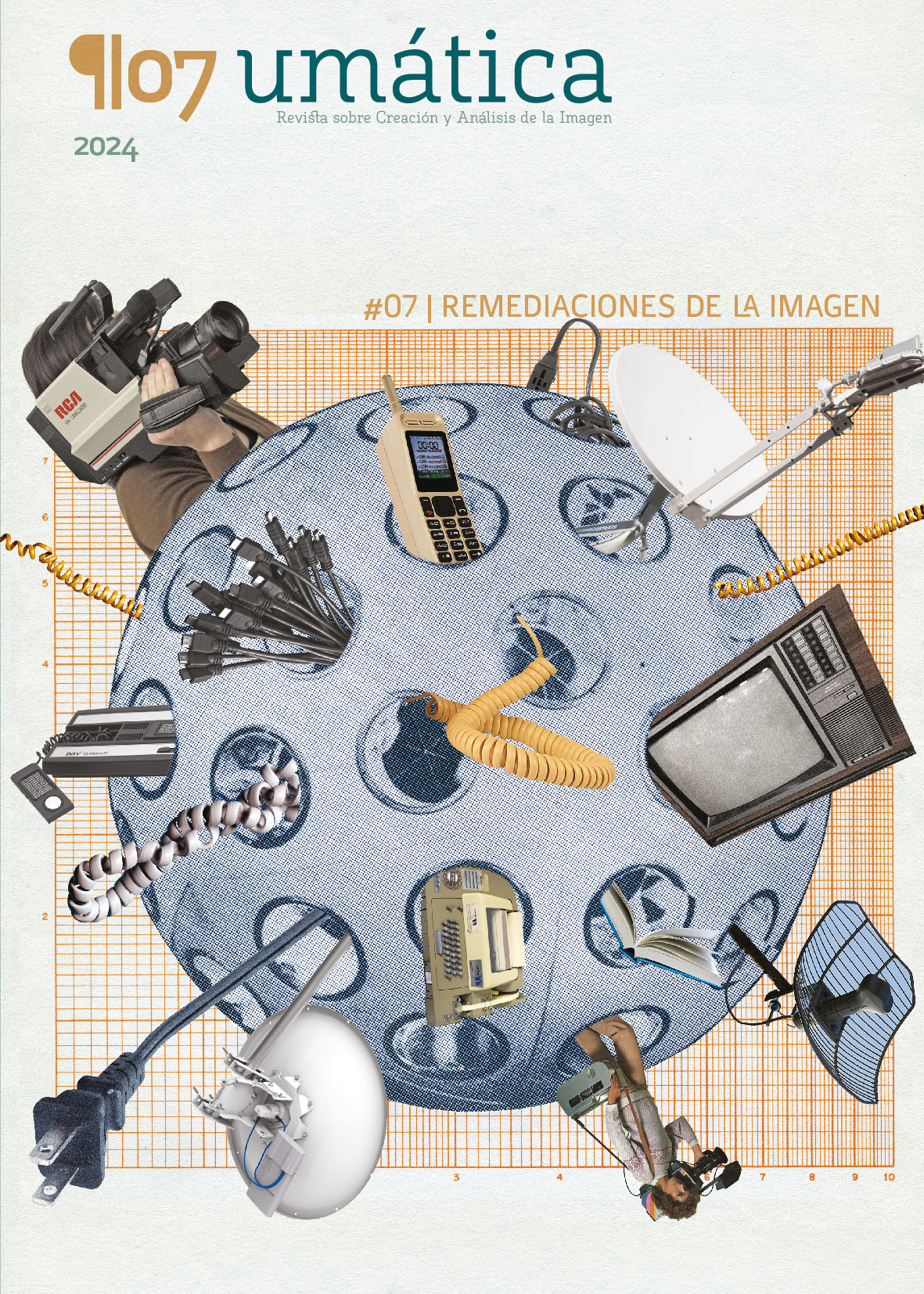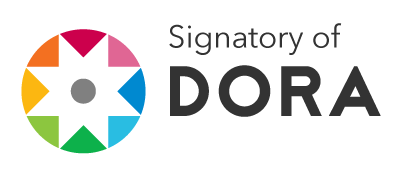Exhausting the Gaze. Interfaces of Images in the Video Essays “My Mulholland” (J. McGoff, 2020) and “Watching The Pain of Others” (C. Galibert-Laîné, 2018)
DOI:
https://doi.org/10.24310/umatica.2024.v6i7.20721Keywords:
surface, interface, remediation, imagination, video essayAbstract
This essay explores the transformations in our ways of seeing images and their implications for contemporary visual culture. It proposes to rethink the relationship of gaze, materiality of the image, and the possibilities of imagination. Instead of simply trying to find new displacements of the gaze, this text offers a reflection on the materiality of images and their remediations in order to open the potential of imagination. The central site that the gaze occupies to address images in visual studies is set into question, especially tackling the images of female bodies. In order to develop this notion, two video essays are brought forward for analysis: My Mulholland (2020), by Jessica McGoff, about the fears of watching David Lynch’s Mulholland Drive (2001) as a female teenager, and Watching The Pain of Others (2018), by Lého Galibert-Laîné, a visual diary that tries to make sense to their fascination for Penny Lane’s film The Pain of Others (2018). Both video essays are bringing forth the spectatorship of an existing film and remediate them, they put them back into the medium, inserting their gaze within the image. These critical video essays question the act of looking by exploring the interfaces of their images –that is, the material sites of contact or limit between two media. It is from that place, I argue, that the possibilities of an imagination that exhausts the gaze can be engaged.
Downloads
Metrics
Publication Facts
Reviewer profiles N/A
Author statements
Indexed in
-
—
- Academic society
- N/A
- Publisher
- Universidad de Málaga (España)
References
Alloa, E. (2020). Partages de la perspective. Fayard.
Alonso de la Fuente, Á. (2022). Sobre una posible crítica cinematográfica para una mirada anestesiada. Ñawi, 6(1). https://doi.org/10.37785/nw.v6n1.a2.
Avissar, A. y Kreutzer, E. (2020). Introduction. “Once Upon a Screen”: Screen Traumas and Cinephilic Hauntings. The Cine-Files, (15). https://www.thecine-files.com/once-upon-a-screen-introduction/.
Baptista, T. (2016). Lessons in looking: the digital audiovisual essay [Tesis doctoral. Birkbeck, University of London]. http://eprints.bbk.ac.uk/id/eprint/40215.
Barrios, J. L. (2012). Aporías de la superficie: quiasmo, hiato. Consideraciones en torno al animal, el cuerpo y la carne. En L. Guerrero Martínez (Ed.), Dialécticas de la corporeidad (pp. 61-81). Universidad Iberoamericana.
Benjamin, W. (2003). La obra de arte en la época de su reproductibilidad técnica. Ítaca.
Berger, J., Blomberg, S., Fox, C., Dibb, M. y Hollis, R. (2006). Modos de ver. Gustavo Gili.
Berger, J. y Dibb, M. (1972). Ways of Seeing. BBC Two.
Bermúdez Dini, R. (2024). Los intersticios de la imagen: economías de lo (in)visible e imaginación iconoclasta. Eikon / Imago, 13. https://doi.org/10.5209/eiko.90234.
Bernstein, P. (2016). What is a Video Essay? Creators Grapple with a Definition. Filmmaker Magazine.
https://filmmakermagazine.com/98248-what-is-a-video-essay-creators-grapple-with-a-definition.
Bino, C. (2016). To See and to Be Seen. Comunicazioni sociali, (2), 203–216.
https://www.torrossa.com/gs/resourceProxy?an=3161191&publisher=FM8160.
Binotto, J. (2021). Practices of Viewing. https://transferences.org/videoessays/practices-of-viewing.
Binotto, J. (2024). Unsettling bodies. Video essay as embodied research. Akademisk Kvarter, (27), 57–70.
https://doi.org/10.4324/9781315722344.
Bolter, J. D. y Grusin, R. (1999). Remediation. Understanding new media. MIT Press.
Bottici, C. (2019). Imagination, Imaginary, Imaginal: Towards a New Social Ontology. Social Epistemology, 33(5), 433–441. https://doi.org/10.1080/02691728.2019.1652861.
Bruno, G. (2020). Surface Tension, Screen Space. En Screen Space Reconfigured (pp. 35-54). Amsterdam University Press.
Bryson, N. (1991). Visión y pintura. La lógica de la mirada. Alianza Editorial.
Buck-Morss, S. (1993). Estética y anestésica. Una revisión del ensayo de Walter Benjamin sobre la obra de arte. La balsa de la Medusa, 25, 55–98.
Crary, J. (1990). Techniques of the observer. On vision and modernity in the nineteenth century. MIT Press.
Culp, E. (2020). El recuerdo de una mirada. Superficies de la imagen fílmica. Designio. Investigación en diseño y estudios de la imagen, 2(1), 84–103. https://doi.org/10.52948/ds.v2i1.106.
Deleuze, G. (1995). The exhausted. SubStance, 24(78), 3–28. http://www.jstor.org/stable/3685005.
Farocki, H. (1995). Schnittstelle / Interface. Musée Moderne d’art de Villeneuve d’ Ascq; Harun Farocki Filmproduktion, Berlin.
Frank, H. (1978). Ten Minutes Older. Riga Motion Picture Studios.
Galibert-Laîné, L. (2018). Watching The Pain of Others [Videoensayo].
https://lehogalibertlaine.com/watching-the-pain-of-others.
Grant, C. (2014). The shudder of a cinephiliac idea? Videographic film studies practice as material thinking. Aniki: Revista Portuguesa da Imagem em Movimento, 1(1), 49–62.
http://www.aim.org.pt/ojs/index.php/revista/article/view/59/35.
Hookway, B. (2014). Interface. MIT Press.
Hüppauf, B.-R. y Wulf, C. (2009). The Indispensability of Imagination. En B.-R. Hüppauf y C. Wulf (Eds.), Dynamics and performativity of imagination : the image between the visible and the invisible (pp. 1-18). Routledge.
Jay, M. (2008). Ojos abatidos. La denigración de la visión en el pensamiento francés del siglo XX. Akal.
Kiarostami, A. (2008). Shirin [Film]. Abbas Kiarostami Productions.
Lane, P. D. (2018). The Pain of Others [Filme]. Wishful Thinking.
https://pennylaneismyrealname.com/film/the-pain-of-others-2018.
Lizarazo, D. (2024). Mirada matriz y potencia oscura de la mirada. Aisthesis, (75), 151–169.
https://doi.org/10.7764/Aisth.75.8.
López Cuenca, A. (2018). ¿De quiénes son las imágenes? La Historia del arte en la era Betamax. En V. García Pérez (Ed.), La vorágine de las imágenes. Accesos, circuitos, controles, archivos y autorías en el arte (pp. 17-41). Instituto Nacional de Bellas Artes.
Lynch, D. D. (2001). Mulholland Drive [Film]. Les Films Alain Sarde; Asymmetrical Productions; Babbo.
Martínez Bonilla, M. (2023). La potencia del mirar: la poética ética en el cine no-ficcional de Agnès Varda. Dixit, 37(1), 72–81. https://doi.org/10.22235/d.v37i1.3223.
McGoff, J. (2020). My Mulholland Once Upon a Screen [Videoensayo]. The Cine-Files.
Mirzoeff, N. (2011). The right to look. Critical Inquiry, 37(3), 473–496. https://doi.org/10.1515/9780822393726/pdf.
Mondzain, M.-J. (2003). Le commerce des regards. Éditions du Seuil.
Mondzain, M.-J. (2009). What is: Seeing an Image? En B.-R. Hüppauf y C. Wulf (Eds.), Dynamics and performativity of imagination: the image between the visible and the invisible (pp. 81-92). Routledge.
Mondzain, M.-J. (2010). What Does Seeing an Image Mean. Journal of Visual Culture, 9(3), 307–315.
https://doi.org/10.1177/1470412910380349.
Mulvey, L. (1975). Visual Pleasure and Narrative Cinema. Screen, 16(3), 6–18. https://doi.org/10.1093/screen/16.3.6.
Mulvey, L. (2001). Placer visual y cine narrativo. En B. Wallis (Ed.), Arte después de la modernidad (pp. 365-377). Akal.
Mulvey, L. (2006). Death 24x a second. Stillness and the moving image. Reaktion Books.
Rodríguez-Blanco, S. (2022). Fotodocumentalismo y memoria queer/cuir en México. Disputas por lo visible y encuadres escriturarios desde las disidencias sexogenéricas. Discursos Fotográficos, 19(32), 131–155.
https://doi.org/10.5433/1984-7939.2022v19n32p131.
Silverman, K. (1992). Male subjectivity at the margins. Routledge.
Silverman, K. (1996). The threshold of the visible world. Routledge.
Somorjai, G. A. y Li, Y. (2011). Impact of surface chemistry. Proc Natl Acad Sci U S A, 108(3), 917–924.
https://doi.org/10.1073/pnas.1006669107.
Soto Calderón, A. (2022). Imaginación material. Metales pesados.
Weber, S. (2008). Benjamin’s -abilities. Harvard University Press.
Zecchi, B. (2024). An accented video way of thinking: Becoming videoessay. Academic Quarter Akademisk kvarter, 25–34. https://panopto.aau.dk/Panopto/Pages/Viewer.aspx?id=44841c3d-918d-4172-8884-b17700a99ef1.
Downloads
Published
How to Cite
Issue
Section
License
Copyright (c) 2024 Edwin Culp

This work is licensed under a Creative Commons Attribution-NonCommercial-ShareAlike 4.0 International License.
All contens publishes in Umática.Revista sobre Creación y Anáisis de la Imágen are protected under the Creative Commos Attribution-NonComercial-ShareAlike 4.0 International (CC-BY-NC-SA 4.0) license.
All about this license is available in the following link: <http://creativecommons.org/licenses/by-nc-sa/4.0>
Users can copy, use, redistribute, share and exhibit publicly as long as:
- The original source and authorship of the material are cited (Journal, Publisher and URL of the work).
- It is not used for comercial purposes.
- The existence of the license and its especifications are mentioned.
There are two sets of authors’ rights: moral and property rights. Moral rights are perpetual prerogatives, unrenounceable, not-transferable, unalienable, imprescriptible and inembargable. According to authors’ rights legislation, Umática.Revista sobre Creación y Anáisis de la Imágen recognizes and respects authors moral rights, as well as the ownership of property rights, which will be transferred to University of Malaga in open access. The property rights are referred to the benefits that are gained by the use or the dissemination of works. Fotocinema. Umática.Revista sobre Creación y Anáisis de la Imágen is published in an open access form and it is exclusively licenced by any means for doing or authorising distribution, dissemination, reproduction, , adaptation, translation or arrangement of works.
Authors are responsable for obtaining the necessary permission to use copyrighted images.
Copyright note: Authors who have publications with this journal agree and certify to the following terms:
- That he/she has contributed directly to the intellectual content of the work, for which he/she is responsible for all purposes.
- That he/she approves the contents of the manuscript submitted to the editorial process of UMÁTICA, REVISTA SOBRE CREACIÓN Y ANÁLISIS DE LA IMAGEN, and therefore agrees that his/her name appears as the author(s).
- That the content of the article has not been published and that it does not appear in any other work that is about to be published.
- That he/she agrees not to submit it for consideration of another publication while it is in the process of being reviewed by UMÁTICA, REVISTA SOBRE CREACIÓN Y ANÁLISIS DE LA IMAGEN, nor later in case it is accepted for publication.
- That he/she has not had, nor does any personal or financial affiliations that could prejudice the development or results of the present work.
- That all those persons who have made a substantial contribution to the development of the work, having given their permission for the mention, have been mentioned in the acknowledgments section.
- That he/she agrees to provide, when required by the journal, access to all the data and sources on which the work presented is based.
- That he/she will actively participate in the realization of all those stylistic or orthographic-typographic modifications necessary for the publication of the work when notified by the journal's editorial team.
- That he/she has not violated, and nor will, the laws and human or animal rights during the process of research and publication of this work.
- That, none of the institutions in which he/she carries out his/her scientific and research work has presented objections to the publication of the manuscript submitted for evaluation.
- That data and references to materials published are credited and included in the references and citations and, in the cases required, have the due authorizations of those who own the patrimonial rights.
- That any material used is free of copyright. Author(s) is responsible for any litigation or claim related to intellectual property rights, exonerating UMÁTICA, REVISTA SOBRE CREACIÓN Y ANÁLISIS DE LA IMAGEN (UMÁTICA, CREATION AND ANALYSIS OF IMAGE JOURNAL) of any responsibility.
- That in case the work is approved for publication, authorizes the publisher to include the text in the journal UMÁTICA, REVISTA SOBRE CREACIÓN Y ANÁLISIS DE LA IMAGEN and to reproduce, edit, distribute, exhibit and communicate it in the country and abroad by printed, electronic, CD, Internet or any other means known or to be known.







23.png)






